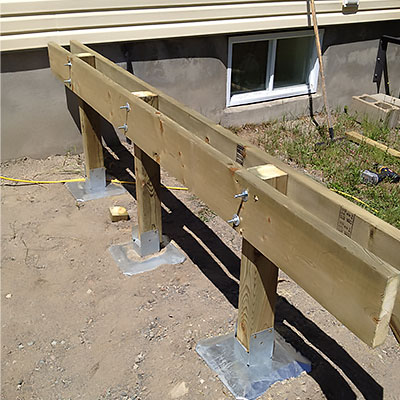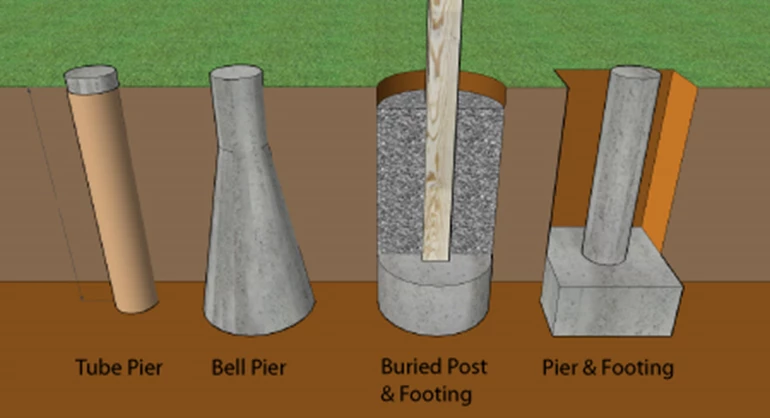A Solid Foundation for Your Sanctuary: Exploring the Value of Deck Footings in Outdoor Frameworks
A Solid Foundation for Your Sanctuary: Exploring the Value of Deck Footings in Outdoor Frameworks
Blog Article
Choosing the Right Deck Footings for Security and Toughness
When it involves building a deck, one of one of the most essential decisions you will make is selecting the right grounds for stability and durability. The durability and safety of your deck depend heavily on the sort of footings you choose, as they give the vital assistance and stability to endure the test of time. With a myriad of choices offered, it can be frustrating to determine which footings are best matched for your particular needs. In this conversation, we will check out the different sorts of deck footings, think about the essential factors to evaluate when deciding, and look into the benefits and drawbacks of different choices. By the end, you will certainly have a more clear understanding of the options at hand and be far better equipped to make an informed choice for your deck job.
Kinds Of Deck Grounds
These grounds are composed of a cylindrical hole filled up with concrete, which gives a strong foundation for the deck blog posts. Concrete pier footings are reasonably simple to mount and offer excellent stability, making them a preferred option for numerous deck projects.
These grounds are mounted by screwing them right into the ground, which creates a protected foundation for the deck. They also permit for very easy modification and progressing of the deck if needed.
Alternatively, some building contractors go with precast concrete grounds. These footings are made from durable concrete and come in numerous sizes and shapes to suit various deck layouts. Precast concrete footings are practical to mount and supply a stable base for the deck structure.
Finally, another choice is the post-in-anchor ground system. This kind of footing involves driving a steel support into the ground and affixing it to the deck article. It provides versatility in terms of positioning the deck posts and appropriates for decks with lightweight frameworks.
When selecting the ideal kind of deck footing, it is necessary to consider elements such as soil problems, deck tons, and local building codes (Deck Footings). Consulting with a professional specialist or architectural engineer can assist make certain the ideal ground is selected for a secure and steady deck
Aspects to Think About When Picking Grounds
When picking the appropriate grounds for a deck, it is essential to meticulously consider different variables such as soil conditions, deck load, and adherence to local building codes. These factors play a considerable function in guaranteeing the security and toughness of the deck structure.
The kind of soil on which the deck will certainly be constructed identifies the kind of grounds needed. On the other hand, decks built on clay or large dirts may call for grounds that can accommodate the dirt's tendency to increase and agreement.
One more crucial factor is the deck lots. The weight of the deck, consisting of the materials made use of and any potential real-time lots such as furniture or celebrations, must be taken into consideration when choosing grounds. The footings should be created to bear the weight of the deck and disperse it uniformly to stop any type of structural concerns or failings.
Finally, adherence to regional structure codes is vital. Structure codes vary from region to area, and it is important to conform with the specific demands set by the local authorities. Deck Footings. These codes guarantee that the deck get more is built safely and meets the necessary standards for architectural honesty and load-bearing ability
Concrete Grounds: Cons and pros

Concrete footings use a number of benefits and disadvantages when used as the structure for a deck. On the positive side, concrete footings supply exceptional security and longevity.
An additional advantage of concrete footings is their versatility. They can be put into various sizes and shapes to accommodate various deck designs and configurations. Concrete grounds can be personalized to fit the certain demands and needs of the deck framework.
Nonetheless, there are also some disadvantages to utilizing concrete footings. One major negative aspect is the expense and labor associated with their setup. Concrete footings require excavation and often need the support of hefty equipment. This can increase the overall cost of the deck project and may require professional aid.

Helical Piers Vs. Sonotubes: Which Is Much better?
In considering the foundation choices for a deck, the comparison between helical piers and sonotubes is important in establishing the superior option. Helical piers, also called screw heaps, are steel shafts with helical plates affixed to them. They are twisted right into the ground utilizing hydraulic machinery, supplying a long lasting and stable structure for the deck. On the other hand, sonotubes are cylindrical types constructed from cardboard or fiber official website material that are full of concrete. They are positioned in an opening explored the ground and offer assistance for the deck.
The helical plates on the piers produce a solid hold with the soil, moving or protecting against any movement of the deck. Sonotubes, on the other hand, count entirely on the concrete filling up for security, which might not offer the exact same degree of strength and resistance.
In regards to setup, helical piers are relatively simpler and faster to mount compared to sonotubes. The hydraulic machinery utilized to twist the piers right into the ground makes sure a reliable and quick process. Sonotubes, on the various other hand, call for excavating holes and putting concrete, which can be taxing and labor-intensive.
Furthermore, helical piers are a more functional alternative. They can be made use of in numerous dirt conditions and can be readjusted or enhanced if required. Sonotubes, on the other hand, might call for added assistance, such as rebar, in particular soil problems or areas with high lots needs.
Selecting the Right Footings for Your Deck's Measurements
For ideal structural integrity, it is vital to thoroughly choose the proper grounds that straighten with the dimensions of your deck. The measurements of your deck, including its elevation, length, and width, play a considerable role in establishing the kind and dimension of grounds required.
When selecting grounds for your deck, it is very important to consider the load-bearing ability of the soil. The weight of the deck, integrated with the weight of any type of furnishings or individuals on it, applies a significant pressure on the footings (Deck Footings). It is important to pick footings that can effectively sustain this weight without moving or sinking over time.
Bigger decks with higher measurements require larger footings to offer enough stability and assistance. The form of the footings, whether they are square or rounded, depends on the design and layout of the deck.
Conclusion
To conclude, picking the right deck footings is essential for making sure security and longevity. Factors such as the kind of footings, the deck's measurements, and the benefits and drawbacks of various alternatives should be taken into consideration. Concrete grounds supply toughness and long life, yet might be a lot more taxing and pricey to mount. Helical piers and sonotubes have their very own benefits and downsides. Inevitably, picking the suitable grounds for your deck's certain demands is necessary for a successful and long-lasting structure.
These footings are composed of a round hole filled with concrete, which offers a solid foundation for the deck messages. Concrete pier footings are fairly very easy to mount and provide superb blog here security, making them a popular choice for lots of deck tasks.
Precast concrete grounds are practical to install and supply a steady base for the deck framework.
It provides adaptability in terms of positioning the deck blog posts and is suitable for decks with lightweight structures.
Concrete footings provide several advantages and drawbacks when utilized as the structure for a deck.
Report this page